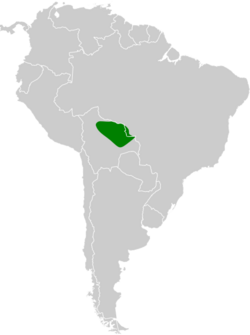Biology:Double-collared crescentchest
| Double-collared crescentchest | |
|---|---|

| |
| Scientific classification | |
| Domain: | Eukaryota |
| Kingdom: | Animalia |
| Phylum: | Chordata |
| Class: | Aves |
| Order: | Passeriformes |
| Family: | Melanopareiidae |
| Genus: | Melanopareia |
| Species: | M. bitorquata
|
| Binomial name | |
| Melanopareia bitorquata (d'Orbigny & Lafresnaye, 1837)
| |

| |
The double-collared crescentchest (Melanopareia bitorquata) is a species of bird in the family Melanopareiidae. It is found in eastern Bolivia.[1][2]
Taxonomy and systematics
The crescentchests (genus Melanopareia) were previously included in family Rhinocryptidae, the tapaculos. A 2010 publication confirmed earlier work and created the present genus.[3][4] The International Ornithological Congress (IOC) recognizes the double-collared crescentchest as a species.[1] However, the South American Classification Committee of the American Ornithological Society (AOS) and the Clements taxonomy consider it to be a subspecies of collared crescentchest (Melanopareia torquata bitorquata).[3][5]
Description
The double-collared crescentchest has a similar pattern to that of the collared crescentchest but the colors are deeper or different in several areas. Its upper parts are olive brown rather than brown and the underparts a deep ochre instead of buff. It has the same black-bordered white supercilium but the "collar" at the back of the neck is a deeper rufous shade and has a black border.[6]
Distribution and habitat
The double-collared crescentchest is found in Bolivia's Santa Cruz Department and the western edge of Brazil's Mato Grosso State. It inhabits cerrado, a biome characterized by a mix of savannah and woodlands.[6]
Behavior
The double-collared crescentchest's diet has not been described but the species is assumed to be insectivorous.[6] Examples of its song are here [1].
Status
The IUCN has not assessed the double-collared crescentchest.
References
- ↑ 1.0 1.1 Gill, F.; Donsker, D.; Rasmussen, P. (January 2021). "IOC World Bird List (v 11.1)". https://www.worldbirdnames.org/.
- ↑ Lopez, Leonardo; Gonzaga, Luiz Pedreira (November 2016). "Melanopareia bitorquata (d'Orbigny & Lafresnaye, 1837) is a distinct species: An appraisal of morphological variation in the Collared Crescentchest Melanopareia torquata (zu Wied-Neuwied, 1831) (Aves: Melanopareiidae)". Zootaxa 4193 (1): 138–150. doi:10.11646/zootaxa.4193.1.6. https://www.researchgate.net/publication/310361624_Melanopareia_bitorquata_d'Orbigny_Lafresnaye_1837_is_a_distinct_species_An_appraisal_of_morphological_variation_in_the_Collared_Crescentchest_Melanopareia_torquata_zu_Wied-Neuwied_1831_Aves_Melanopare.
- ↑ 3.0 3.1 Remsen, J. V., Jr., J. I. Areta, E. Bonaccorso, S. Claramunt, A. Jaramillo, D. F. Lane, J. F. Pacheco, M. B. Robbins, F. G. Stiles, and K. J. Zimmer. Version 19 January 2021. A classification of the bird species of South America. American Ornithological Society. https://www.museum.lsu.edu/~Remsen/SACCBaseline.htm retrieved January 19, 2021
- ↑ Ericson, P.G.P.; Olson, S.L.; Irestedt, M.; Alvarenga, H.; Fjeldså, J. (2010). "Circumscription of a monophyletic family for the tapaculos (Aves: Rhinocryptidae): Psiloramphus [sic] in and Melanopareia out". Journal of Ornithology 151: 337–345.
- ↑ Clements, J. F., T. S. Schulenberg, M. J. Iliff, S. M. Billerman, T. A. Fredericks, B. L. Sullivan, and C. L. Wood. 2019. The eBird/Clements Checklist of Birds of the World: v2019. Downloaded from http://www.birds.cornell.edu/clementschecklist/download/ Retrieved August 15, 2019
- ↑ 6.0 6.1 6.2 Drucker, J. (2020). Collared Crescentchest (Melanopareia torquata), version 1.0. In Birds of the World (T. S. Schulenberg, Editor). Cornell Lab of Ornithology, Ithaca, NY, USA. https://doi.org/10.2173/bow.colcre1.01 retrieved May 2, 2021
Wikidata ☰ Q31874476 entry
 |

